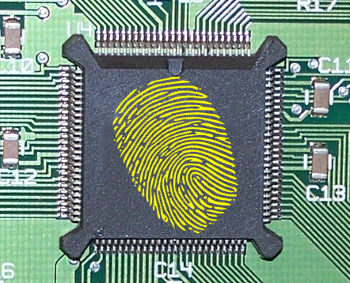Chip Fingerprinting
February 28, 2011
Counterfeiting applies to more than just
currency. Products are counterfeited, also. The downside of a counterfeited handbag is small. The purchaser may have a less useful life from the product, the company that manufactures the genuine handbag losses money on the sale, and it may get a slightly tarnished reputation. When the product is something like an
automotive airbag, counterfeiting can have more severe consequences. Automotive airbags are expensive replacement items, so it's no wonder that counterfeits have appeared on the replacement market. I was once involved in an effort to develop a security device that would detect whether the airbag in a system was genuine. I had some ideas for inexpensive
sensors, but a development program wasn't funded.
The downside of a counterfeit
integrated circuit can be quite significant.
Electronic circuitry are built into myriad
medical devices, military systems, aircraft and automobiles, not to mention billion dollar
communications satellites. IC counterfeiting is typically an easy process. The
silicon chip is always buried in its
molded epoxy package, so the only identification is the external package marking. The counterfeiter just needs to remove the marking from a similarly shaped package and apply a new marking.
The remarking might make it appear that the chip functions at a
higher speed or over a wider
temperature range. The package might contain a similar chip from a different vendor remarked with another vendor's trademark. In the case of
digital circuitry, this is a problem when the designer has relied on
timing specifications for the originally specified chip. It might be that the package is empty inside and completely non-functional. This is actually not the worst-case scenario, because then the problem is detected before the product is in use.[1-2]
The
Semiconductor Industry Association, the
trade association representing the US
semiconductor industry, has been working against chip counterfeiting for many years along with the
World Semiconductor Council (WSC), of which it is a part. A WSC statement in 2008 revealed that a three week enforcement effort had seized 360,000 counterfeit ICs bearing over 40 different
trademarks.[1] It would be nice if those hidden pieces of silicon could contain a tamper-proof identification code; a
fingerprint, so to speak.

Fingerprint image by Wilfredo Rodríguez via Wikimedia Commons.
IC photograph by author)
That's precisely what a team at the
Fraunhofer Institute for Secure Information Technology,
Garching, Germany, has done by using a component's particular
material properties to construct a
digital key. The chip fingerprinting method relies on a correspondence between the digital key and a material property of the silicon circuit that is not easily copied. Fraunhofer researchers will be presenting a prototype of their fingerprinting concept at the
Embedded World Exhibition & Conference (
Nuremberg, Germany), March 1-3, 2011.
Although process engineers try
to make every integrated circuit chip the same, there are inevitable small differences from chip-to-chip for things like
metalization widths and thickness, the dimensions of other feature sizes, and local
dopant levels. These deviations translate into slight differences in
transistor gain and
frequency response. The Fraunhofer Institute researchers add a small additional circuit to each chip that they call a physically unclonable function (PUF); for example, a
ring oscillator. The
frequency of a ring oscillator is very sensitive to the properties of its transistors, so what you get is a different frequency for each chip. You have a fingerprint for the chip that would be extremely hard to set to another value.

A ring oscillator built from three inverters (via Wikimedia Commons).
The Fraunhofer Institute group also developed a "butterfly" physically unclonable function, but there's no description of this implementation.
To my knowledge, I've never been plagued by a counterfeit integrated circuit, but even
hobbyists should beware. Last year,
SparkFun Electronics, a popular internet component source for electronic and computer hobbyists, had an experience with a counterfeit batch of
microcontrollers. The chips contained in the epoxy packages weren't even microcontrollers! They were controllers for use in
buck converters, a type of
DC power supply. SparkFun Electronics has posted on the internet its detective work on these counterfeit ICs, and it makes interesting reading.[4]
References:
- Semiconductor Industry Association, "Anticounterfeiting."
- Daryl Hatano, "Stopping Semiconductor Counterfeiting," SEMICON West (San Francisco, California), July 15, 2009 (0.5 MB PDF File).
- Fingerprint makes chips counterfeit-proof, Fraunhofer Institute Press Release, February 4, 2011.
- Emcee Grady, "Revisiting the Counterfeit ATMega328s," SparkFun Electronics, May 17, 2010; follow up here.
Permanent Link to this article
Linked Keywords: Counterfeiting; currency; automotive airbag; sensor; integrated circuit; electronic circuitry; medical device; communications satellite; silicon; integrated circuit packaging; molded epoxy package; clock rate; temperature; digital circuitry; timing specification; Semiconductor Industry Association; trade association; semiconductor industry; World Semiconductor Council; WSC; trademark; fingerprint; Wilfredo Rodríguez; Fraunhofer Institute for Secure Information Technology; Garching, Germany; material properties; digital key; Embedded World Exhibition & Conference; Nuremberg, Germany; semiconductor device fabrication; metalization; dopant; transistor; gain; frequency response; ring oscillator; frequency; hobbyists; SparkFun Electronics; microcontroller; buck converter; DC; power supply.